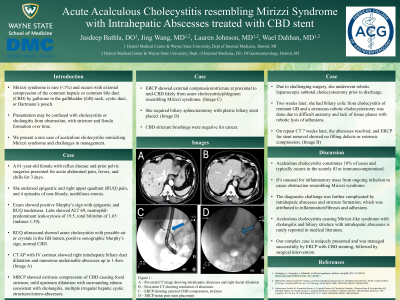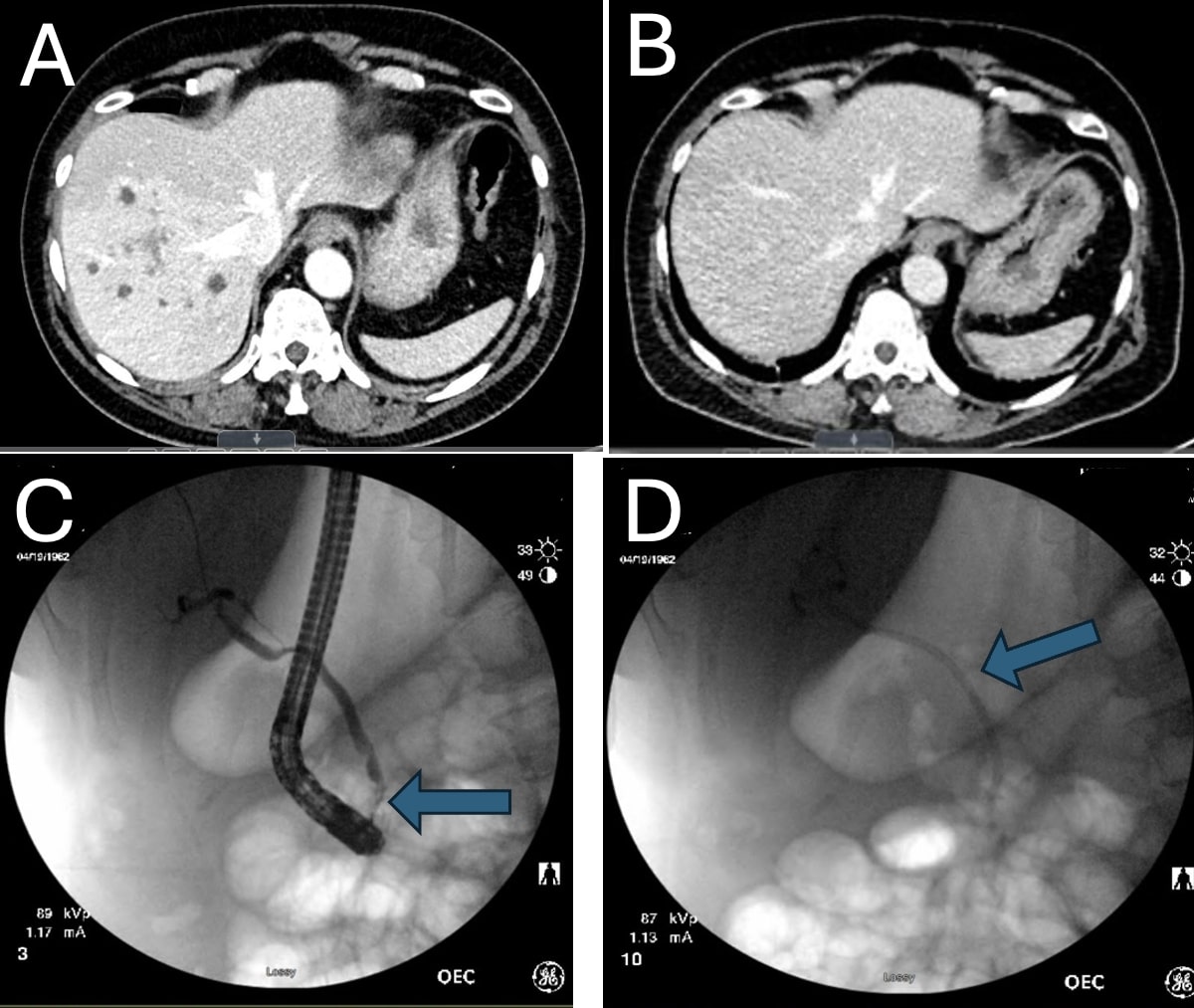Tuesday Poster Session
Category: Interventional Endoscopy
P4548 - Acute Acalculous Cholecystitis Resembling Mirizzi Syndrome With Intrahepatic Abscesses Treated With CBD Stent
Tuesday, October 29, 2024
10:30 AM - 4:00 PM ET
Location: Exhibit Hall E

Has Audio
- JB
Jasdeep Bathla, DO
Detroit Medical Center/Wayne State University
Detroit, MI
Presenting Author(s)
Jasdeep Bathla, DO1, Jing Wang, MD1, Lauren Johnson, MD2, Wael Dahhan, MD3
1Detroit Medical Center/Wayne State University, Detroit, MI; 2Detroit Medical Center, Detroit, MI; 3Wayne State University, Detroit, MI
Introduction: Mirizzi syndrome is rare and occurs with external compression of the common hepatic or common bile duct (CBD) by gallstone in the gallbladder (GB) neck, cystic duct, or Hartmann’s pouch. Presentation may be confused with cholecystitis or cholangitis from obstruction, with stricture and fistula formation over time. We present a rare case of acalculous cholecystitis mimicking Mirizzi syndrome and challenges in management.
Case Description/Methods: A 61-year-old female with reflux disease and prior pelvic surgeries presented for acute abdominal pain, fevers, and chills for 3 days. She endorsed epigastric and right upper quadrant (RUQ) pain, and 4 episodes of non-bloody, nonbilious emesis. Exam showed positive Murphy’s sign with epigastric and RUQ tenderness. Labs showed ALT 69, neutrophil-predominant leukocytosis of 19.5, total bilirubin of 1.65 (indirect 1.39). RUQ ultrasound showed acute cholecystitis with possible air or crystals in the GB lumen, positive sonographic Murphy’s sign, normal CBD. CT AP with IV contrast showed right intrahepatic biliary duct dilatation and numerous undrainable abscesses up to 1.4cm. MRCP showed extrinsic compression of CBD causing focal stricture, upstream dilatation with surrounding edema consistent with cholangitis, multiple irregular hepatic cystic structures/micro-abscesses. ERCP showed external compression of mid-distal CBD from acute cholecystitis/phlegmon resembling Mirizzi syndrome. She required biliary sphincterotomy with plastic biliary stent placed. CBD stricture brushings were negative for cancer. Due to challenging surgery, she underwent robotic laparoscopic subtotal cholecystectomy. Two weeks later, she had biliary colic from cholecystitis of remnant GB and strenuous robotic cholecystectomy was done due to difficult anatomy and lack of tissue planes with robotic lysis of adhesions. On repeat CT 7 weeks later, the abscesses resolved, and ERCP for stent removal showed no filling defects or extrinsic compression.
Discussion: Acalculous cholecystitis constitutes 10% of cases and typically occurs in the acutely ill or immunocompromised. It’s unusual for inflammatory mass from ongoing infection to cause obstruction resembling Mirizzi syndrome. Acalculous cholecystitis causing Mirizzi-like syndrome with cholangitis and biliary stricture with intrahepatic abscesses is rarely reported in medical literature. Our complex case is uniquely presented and was managed successfully by ERCP with CBD stenting, followed by surgical intervention.

Disclosures:
Jasdeep Bathla, DO1, Jing Wang, MD1, Lauren Johnson, MD2, Wael Dahhan, MD3. P4548 - Acute Acalculous Cholecystitis Resembling Mirizzi Syndrome With Intrahepatic Abscesses Treated With CBD Stent, ACG 2024 Annual Scientific Meeting Abstracts. Philadelphia, PA: American College of Gastroenterology.
1Detroit Medical Center/Wayne State University, Detroit, MI; 2Detroit Medical Center, Detroit, MI; 3Wayne State University, Detroit, MI
Introduction: Mirizzi syndrome is rare and occurs with external compression of the common hepatic or common bile duct (CBD) by gallstone in the gallbladder (GB) neck, cystic duct, or Hartmann’s pouch. Presentation may be confused with cholecystitis or cholangitis from obstruction, with stricture and fistula formation over time. We present a rare case of acalculous cholecystitis mimicking Mirizzi syndrome and challenges in management.
Case Description/Methods: A 61-year-old female with reflux disease and prior pelvic surgeries presented for acute abdominal pain, fevers, and chills for 3 days. She endorsed epigastric and right upper quadrant (RUQ) pain, and 4 episodes of non-bloody, nonbilious emesis. Exam showed positive Murphy’s sign with epigastric and RUQ tenderness. Labs showed ALT 69, neutrophil-predominant leukocytosis of 19.5, total bilirubin of 1.65 (indirect 1.39). RUQ ultrasound showed acute cholecystitis with possible air or crystals in the GB lumen, positive sonographic Murphy’s sign, normal CBD. CT AP with IV contrast showed right intrahepatic biliary duct dilatation and numerous undrainable abscesses up to 1.4cm. MRCP showed extrinsic compression of CBD causing focal stricture, upstream dilatation with surrounding edema consistent with cholangitis, multiple irregular hepatic cystic structures/micro-abscesses. ERCP showed external compression of mid-distal CBD from acute cholecystitis/phlegmon resembling Mirizzi syndrome. She required biliary sphincterotomy with plastic biliary stent placed. CBD stricture brushings were negative for cancer. Due to challenging surgery, she underwent robotic laparoscopic subtotal cholecystectomy. Two weeks later, she had biliary colic from cholecystitis of remnant GB and strenuous robotic cholecystectomy was done due to difficult anatomy and lack of tissue planes with robotic lysis of adhesions. On repeat CT 7 weeks later, the abscesses resolved, and ERCP for stent removal showed no filling defects or extrinsic compression.
Discussion: Acalculous cholecystitis constitutes 10% of cases and typically occurs in the acutely ill or immunocompromised. It’s unusual for inflammatory mass from ongoing infection to cause obstruction resembling Mirizzi syndrome. Acalculous cholecystitis causing Mirizzi-like syndrome with cholangitis and biliary stricture with intrahepatic abscesses is rarely reported in medical literature. Our complex case is uniquely presented and was managed successfully by ERCP with CBD stenting, followed by surgical intervention.

Figure: Figure 1:
A – Pre-stent CT image showing intrahepatic abscesses and right ductal dilatation
B – Post-stent CT showing resolution of abscesses.
C – ERCP showing filling defects and narrowing.
D – ERCP status post biliary stent placement.
A – Pre-stent CT image showing intrahepatic abscesses and right ductal dilatation
B – Post-stent CT showing resolution of abscesses.
C – ERCP showing filling defects and narrowing.
D – ERCP status post biliary stent placement.
Disclosures:
Jasdeep Bathla indicated no relevant financial relationships.
Jing Wang indicated no relevant financial relationships.
Lauren Johnson indicated no relevant financial relationships.
Wael Dahhan indicated no relevant financial relationships.
Jasdeep Bathla, DO1, Jing Wang, MD1, Lauren Johnson, MD2, Wael Dahhan, MD3. P4548 - Acute Acalculous Cholecystitis Resembling Mirizzi Syndrome With Intrahepatic Abscesses Treated With CBD Stent, ACG 2024 Annual Scientific Meeting Abstracts. Philadelphia, PA: American College of Gastroenterology.

